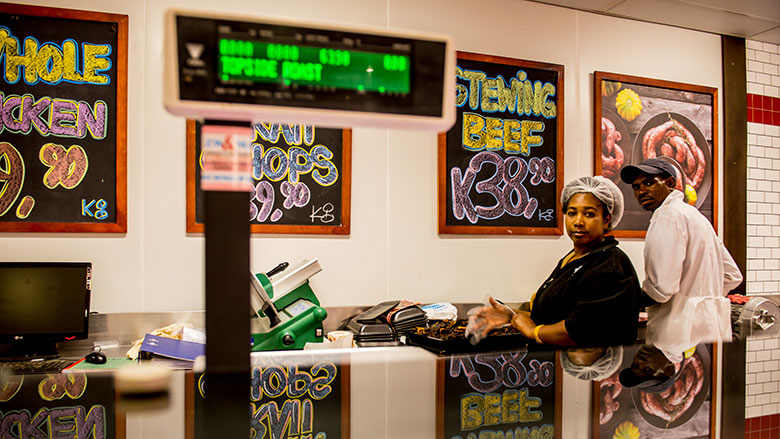Mary Banda runs a small restaurant in Kamwala market, one of Lusaka’s oldest markets. She uses the proceeds from her business to feed her children and pay their school fees. Before she learned that financial services could make the way she did business easier, her profits were low. But now, her monthly profits have increased by 50 percent, both because she banks her money and because she uses mobile money transfer services.
 Mary Banda is a living proof that financial inclusion has positive effects on alleviating an individual’s poverty, as well as a wider impact on private sector development and financial sector stability overall. Almost 40 percent of Zambia’s adult population are formally financially included, or over 3.5 million people. This is according to the FinScope Zambia 2015 survey, which says the levels of formal financial inclusion have gradually increased in Zambia—from 23 percent of Zambian adults in 2009, to 38 percent in 2015.
Mary Banda is a living proof that financial inclusion has positive effects on alleviating an individual’s poverty, as well as a wider impact on private sector development and financial sector stability overall. Almost 40 percent of Zambia’s adult population are formally financially included, or over 3.5 million people. This is according to the FinScope Zambia 2015 survey, which says the levels of formal financial inclusion have gradually increased in Zambia—from 23 percent of Zambian adults in 2009, to 38 percent in 2015.
This is due to more financial access point coverage and concerted government efforts to create an environment conducive to greater inclusion. Women are still more financially excluded, though, with only 2 out of 5 having access to formal financial services.
Mary is among the 2 out of 5.
She owns a bank account and uses mobile services, such as Zoona, to send money to her child, who is studying at university. “Women must not fear banks,” she said. “It is very important to save money because the informal sector where we operate has no social security.”
“Financial services must bring their services closer by opening banking kiosks,” she added. “Many women in markets are discouraged from saving in banks, because it is time consuming and they cannot leave their businesses unattended for a long time.”
World Bank support
The World Bank is helping the Zambian government to advance financial inclusion through the Financial Inclusion Support Framework Country Support Program(FISF-CSP). “The Bank’s support will contribute to increasing the usage, access, and quality of financial services for individuals and enterprises,” said Ina Ruthenberg, World Bank Country Manager for Zambia.
This support from FISF-CSP involves: the development of the National Financial Inclusion Strategy and its early implementation; the development of financial infrastructure; the strengthening of financial consumer protection and financial capability; and the promotion of diversified financial services.
And now Zambia has joined more than 30 countries to launch strategies for financial inclusion.
On November 8, 2017, the Government of Zambia disseminated three documents—the Strategy (referred to above), the Financial Sector Development Policy, and Financial Capability Survey Report. All three documents are the product of extensive consultations with members of the public sector, private sector, civil society organizations, and academia.
“Enhancing the financial sector will enable all Zambians to reap the full benefit of financial inclusion,” said Zambia’s Finance Minister, Felix Mutati. He said these improvements included helping individuals find the right savings, credit, payment, insurance, and investment services to plan and manage their risks, and helping firms access affordable financing to facilitate innovation, growth, and employment.
“The strategy will provide a detailed roadmap and concrete actions to build an inclusive and competitive financial sector in Zambia”, said Uzma Khalil, the Bank’s Country Senior Financial Sector Specialist. “Successful implementation of the strategy requires strong commitment and concerted efforts from all stakeholders—the government, private sector, civil society and the academia.”
By 2022, the financial inclusion strategy aims to meet its targets, such as an increase in Zambia’s overall financial inclusion rates—from 59 percent now to 80 percent in 2022 (this includes formal and informal financial services)—and an increase in formal financial inclusion from the current 38 percent to 70 percent.
It is also aiming for improving people’s physical access to high-quality financial services—such as bank branches, agents, and ATMs—so the number of financial access points per 10,000 adults increases from about 7 to 10.




























